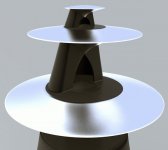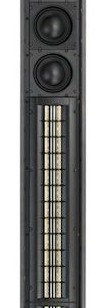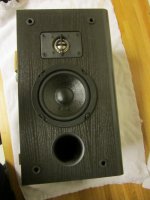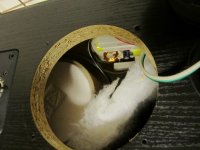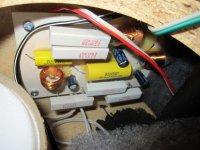On the next page of that series Floyd Toole says that a CBT (horizontal?) is nearly perfect surround peaker
Loudspeakers: Objective evaluations - Part 4: Measurements of real-world consumer loudspeakers | EE Times
Interesting, I will see if this corresponds to my own experiences - that a wider, but controlled dispersion is preferred.
Computer simulations allowed for a significant reduction in development time, did the crossover adjustments in basically less than a week.
What software are you using?
I have been out of speaker building for (too) many years .... and the last software I used was Calsod!!!!!! ......
Looking for something, preferably freeware, or not expensive ....
Using / will use HOLMimpulse for measurement .... seems very easy to use.
Seems like a super cool project you have goind .....
.... agree about the media industry .... it's essentially a bad spiral .... people are listening to music through 1" speakers, and movies are something seen o a flatscreen with even smaller speakers ..... and the industry is trying to optimize the sond for that ...... compression ..... very sad story

Interesting, I will see if this corresponds to my own experiences - that a wider, but controlled dispersion is preferred.
Yes that is interesting, as you also suggested Juhazi .... wide dispersion .....
But if this is/could be the goal for a design, then as suggested by Juhazi, much fewer speaker elements are neded ..... by use of some kind of difusor or wave guide, you would only need 1 or 2 drivers ....
Maybe something like the B&O acoustic lenses (but adopted to wall placement) could be a way to go .....
Attachments
Yes that is interesting, as you also suggested Juhazi .... wide dispersion .....
But if this is/could be the goal for a design, then as suggested by Juhazi, much fewer speaker elements are neded ..... by use of some kind of difusor or wave guide, you would only need 1 or 2 drivers ....
Maybe something like the B&O acoustic lenses (but adopted to wall placement) could be a way to go .....
Wide dispersion horizontal but narrow line-source vertical to get more even sound coverage, that is what this article suggests.
A more reasonable approach could be something in the direction you suggest here, with fewer drivers.
The article also criticizes THX for specifying dipoles, and suggests that the dipole concept is fundamentally flawed, and I have to agree that this is one of the points where THX is wrong. To me THX leaves the impression that they do not have a full and complete understanding of electroacoustics, especially when you compare to articles written by Toole, or other competent persons.
Impulse response measurements of surrounds are interesting, the are genrerally very bad due to the large radiation angles, and especially dipoles show a hopeless situation.
What software are you using?
Different sorts of, and I can also simulate dynamic systems by programming.
Look at Hornresp for horn and reflex sims of individual system parts, fast and easy to get a first view.
Akabak is a powerful and nice tool, but you will need to model your system in text files.
Wide dispersion horizontal but narrow line-source vertical to get more even sound coverage, that is what this article suggests.
A more reasonable approach could be something in the direction you suggest here, with fewer drivers.
The article also criticizes THX for specifying dipoles, and suggests that the dipole concept is fundamentally flawed, and I have to agree that this is one of the points where THX is wrong. To me THX leaves the impression that they do not have a full and complete understanding of electroacoustics, especially when you compare to articles written by Toole, or other competent persons.
Impulse response measurements of surrounds are interesting, the are genrerally very bad due to the large radiation angles, and especially dipoles show a hopeless situation.
Well I think THX do know what they are doing, and for small rooms dipoles do make sense ..... my room is only 310 cm wide, so I will have max 1,5 meter to the speaker .... and thats when I'm alone ..... sitting too aside, this distance becomes much less ..... ..... I think it's this which has resulted in the reccomendation/requirement for dipoles ...
But for larger rooms this of coourse does not make the same sense, and I think they should have made more reccomendation or requirements based on size of room.
As for a short line source .... maybe something like the attached ... placed high ..... higher than head hight. This would prevent direct dadiated sound (mid-high), but would have a very wide horizontal dispersion
Attachments
That B&G RD line midtweeter beams like *ell vertically. I would not use it as you said. Uniform dispersion horizontally and vertically is needed to satisfy the whole audience.
In small rooms this gets difficult because change in distance relatively to source distance is so big. In movie theatres and other large halls it is managed by aiming the directivity "peak" to the far-away listener. Then others are at off-axis angle and if spl response remains constant, they will hear same tonality and relative level.
Here is info about acoustic design and speaker distribution for halls, but we can adapt some ideas for home theaters too http://www.jblpro.com/BackOffice/ProductAttachments/cinedsgn[1].pdf
In small rooms this gets difficult because change in distance relatively to source distance is so big. In movie theatres and other large halls it is managed by aiming the directivity "peak" to the far-away listener. Then others are at off-axis angle and if spl response remains constant, they will hear same tonality and relative level.
Here is info about acoustic design and speaker distribution for halls, but we can adapt some ideas for home theaters too http://www.jblpro.com/BackOffice/ProductAttachments/cinedsgn[1].pdf
You will need sufficient vertical dispersion to cover all seats, which usually means quite narrow, but still need a few degrees.
As for dipole working or not, I think the best way to find out is to try.
That is why I think a configurable surround speaker is nice, because then the user can try what works best, and need not rely on figuring out contradicting advices.
As for dipole working or not, I think the best way to find out is to try.
That is why I think a configurable surround speaker is nice, because then the user can try what works best, and need not rely on figuring out contradicting advices.
Did a little more investigation of my own setup.
What started this was that I on certain material found the sound from the sides to be very thin and cardbox like ....
Found that I in the amp setup had my surrounds set to large ..... this will for sure make the sound sound thin as there will be nothing below 110 Hz .... Changed that
Reading more and checking the phase I found that I had the wrong phase on the sides .... the front firing part need to be in phase with the front speakers ... makes sense ...
Changing these have improved the sound. I actually find that it is clear to hear panning sound but it is not so distinct that you hear that it comes from the speaker .....
Took a look inside the speaker as well. One of the small bass speakers has it's own chamber, which makes sense .... so only one bass is playing the low frequency (otherwise it would be cancled out by the other).
Unfortunatly I couldn't easily remove the filter to take a closer look, but it's ok complex to look at ....
Yes a switch to change from dipole to wide would be nice ..... much easier to test out
What started this was that I on certain material found the sound from the sides to be very thin and cardbox like ....
Found that I in the amp setup had my surrounds set to large ..... this will for sure make the sound sound thin as there will be nothing below 110 Hz .... Changed that
Reading more and checking the phase I found that I had the wrong phase on the sides .... the front firing part need to be in phase with the front speakers ... makes sense ...
Changing these have improved the sound. I actually find that it is clear to hear panning sound but it is not so distinct that you hear that it comes from the speaker .....
Took a look inside the speaker as well. One of the small bass speakers has it's own chamber, which makes sense .... so only one bass is playing the low frequency (otherwise it would be cancled out by the other).
Unfortunatly I couldn't easily remove the filter to take a closer look, but it's ok complex to look at ....
Yes a switch to change from dipole to wide would be nice ..... much easier to test out
Attachments
Not wanting to start a new thread on the same/similar topic. I would be most obliged if someone could point me in the right direction regarding wiring a switch for di-pole to bi-pole.
I too am building some surround speakers which will use 1 mid/woofer and 2 tweeters either side of that at 45 degrees. They will "two way" active in that the tweeters will be on one circuit and the woofer on another (with x-overs etc applied individually).
I am not sure how to wire a switch on the tweeters so they can be in, and then out of, phase?
Many thanks,
Peter
I too am building some surround speakers which will use 1 mid/woofer and 2 tweeters either side of that at 45 degrees. They will "two way" active in that the tweeters will be on one circuit and the woofer on another (with x-overs etc applied individually).
I am not sure how to wire a switch on the tweeters so they can be in, and then out of, phase?
Many thanks,
Peter
- Status
- Not open for further replies.
- Home
- Loudspeakers
- Multi-Way
- How to design a dipole surround speaker
